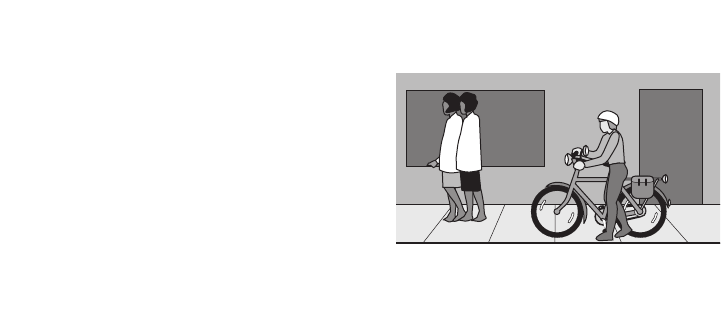
Walk your bike in downtown
areas: they are busy with people
walking out of doorways,
stopping to talk to each other or
window shopping. Many cities
ban bikes from their downtown
sidewalks.
Riding on paths
Paths are wider than sidewalks, but you should still ride cautiously.
Ride on the right and yield to pedestrians. Be especially careful when
crossing a road. When crossing a driveway or street, slow down and be
sure drivers see you.
Ride more slowly and alertly at night, when it’s harder to see the
surface and edges of the path. Pedestrians, joggers, skaters and other
cyclists may approach suddenly out of the dark in front of you.
WHAT TO DO IN CASE OF A CRASH
Check for injuries first. If someone is injured, call for help right away.
Administer first aid if you are trained. After the injured have been
helped and removed from harm’s way, begin gathering information.
If someone has been struck by a car, ask the driver for name and
address, vehicle registration number, driver’s license number, and
insurance policy company and number. Oregon law requires motor
vehicle owners to carry insurance that covers injuries to bicyclists
and pedestrians, and to have proof of insurance. Don’t discuss fault
immediately after the collision. Make sure to write down what you
think happened as soon as possible. Carry identification and medical
insurance information, especially when you cycle alone.
Give your name and address. Ask witnesses, including passengers,
their names and addresses. Do not depend on others to take witness
names and phone numbers.
In case of property damage over $1000 or injury to a person, fill out a
DMV traffic accident report within 72 hours.
Document your injuries and property damage with photographs or
video tape; save all receipts and repair estimates. Contact your insur-
ance company if you have coverage on your bicycle. You may also
want to contact an attorney.
15
Walk your bike on
downtown sidewalks


















